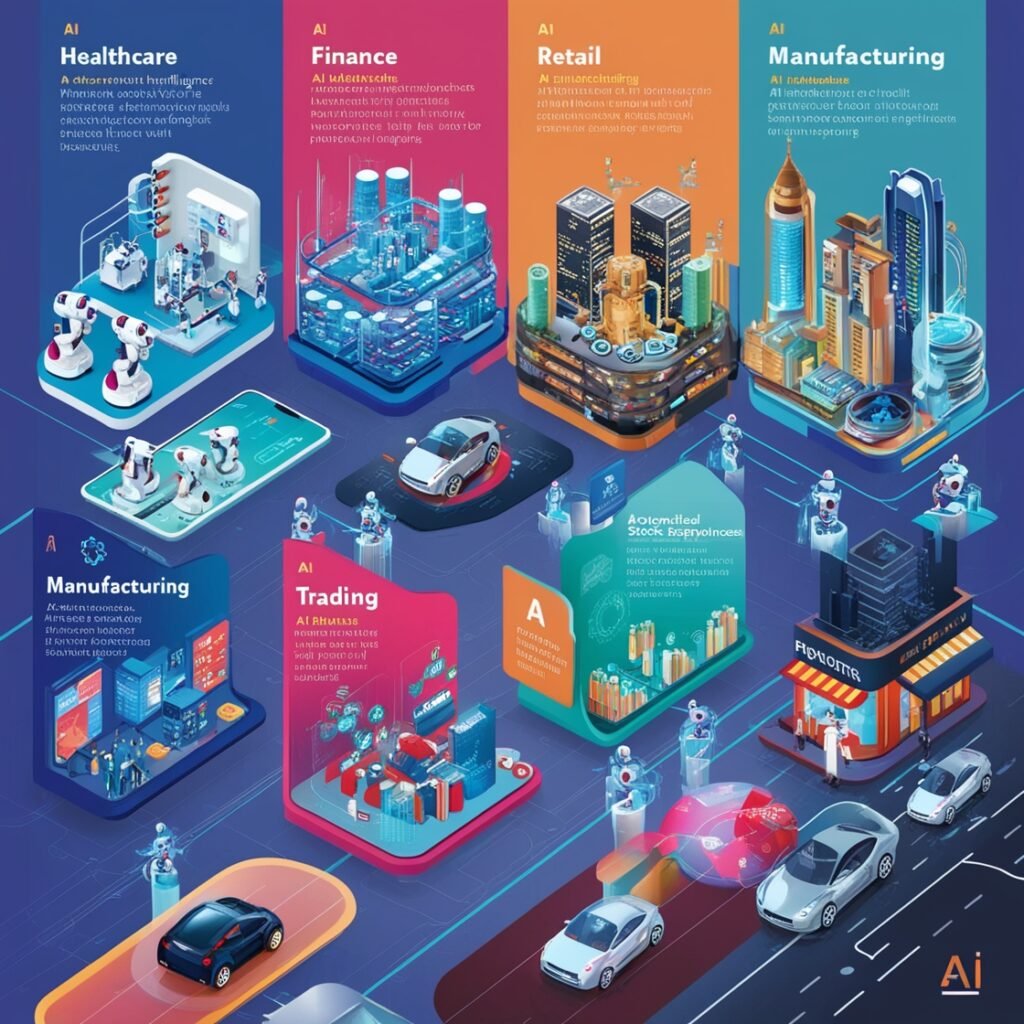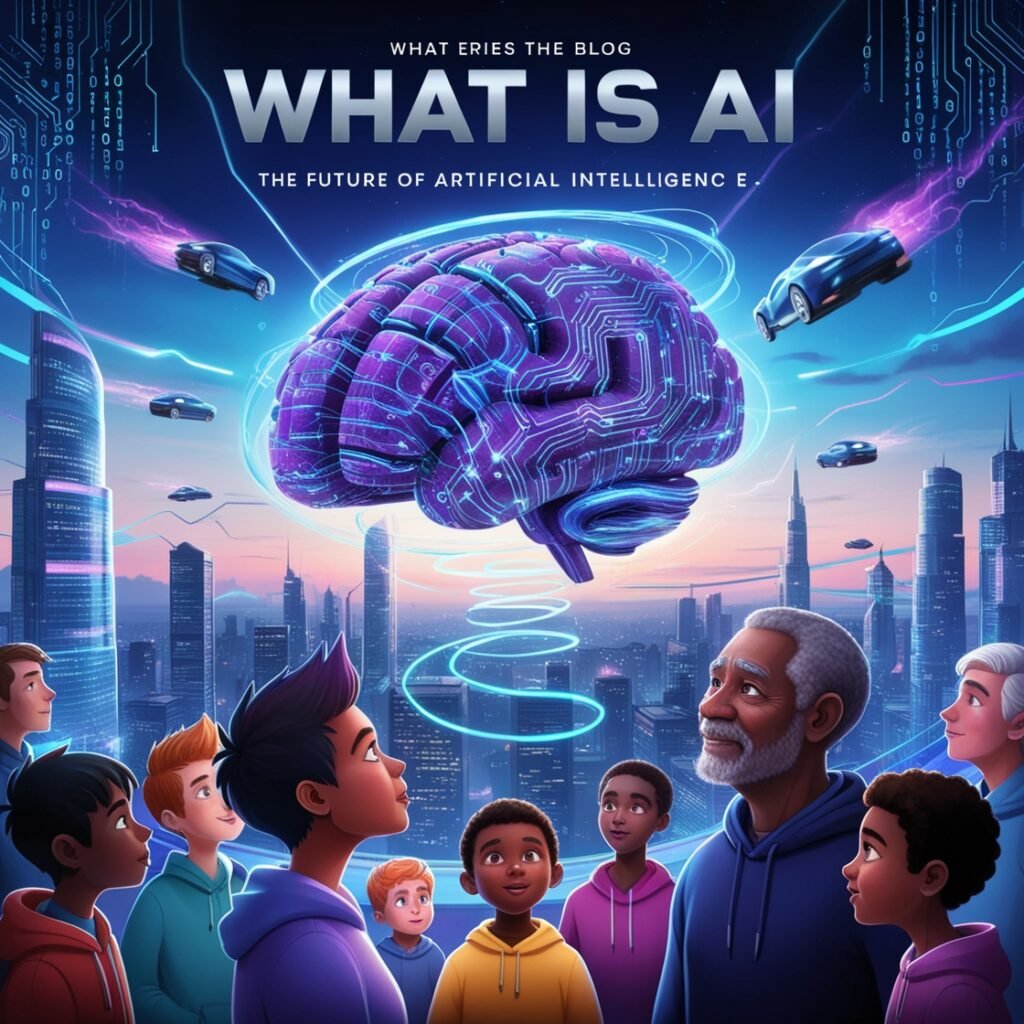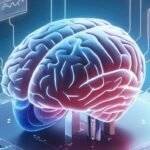Introduction: Artificial Intelligence
Artificial intelligence (AI) has great promise for changing various sectors and facts of daily existence. Artificial Intelligence is the study of how robots, particularly computer systems, replicate human thought processes. Machines are currently able to carry out activities that have historically required human intelligence thanks to these processes, which include learning, thinking, and self-correction.
Definition
The term artificial intelligence (AI) describes the process by which machines mimic human intelligence. These systems are designed to carry out operations like recognizing patterns, data mining, decision-making, and problem-solving that usually demand the human intellect. Artificial intelligence (AI) is utilized in numerous applications, ranging from simple virtual assistants like Siri or Alexa to more sophisticated ones like driverless cars or advanced data processing software.
In short, artificial intelligence (AI) makes it possible for machines to understand and behave like humans can. That generally involves improving or simplifying jobs to make life easier for us.
History and development of AI
The origins of artificial intelligence (AI) may be traced to historical myths, tales, and stories involving intelligent objects. Technology and machines have their roots in Greek mythology, specifically in the story of Tales.
Starting Points
• 1950s: Alan Turing, a British mathematician, puts forth the concept of a machine capable of replicating any mental function in a human. He developed the Turing test in the 1950s, and it is still a foundational idea in AI philosophy.
• 1956: John McCarthy, Marvin Minsky, Nathaniel Rochester, and Claude Shannon organized the Dartmouth Conference, which coined the phrase “artificial intelligence” and marked the emergence of AI as a recognized academic field.
Developmental Trends
1. Symbolic AI (1956–1980s): Symbolic approaches, which capture human knowledge in codes and symbols, were the focus of early AI research. During this time, computers like ELIZA and SHRDLU showed hints of having limited ability to understand natural language..
2. Expert systems (1980s): The 1980s saw a rise in the use of rules-based systems, or expert systems. In certain domains—like medical testing MYCIN, for example—these algorithms replicated the decision-making capabilities of a human expert.
3. Neural Networks (1980s–1990s): In the 1980s, neural networks—which are inspired by the human brain—started returning. Machine learning is seeing a rebirth because of backpropagation, a tool that trains neurons.
The Modern AI Boom (2000-Present)
• Deep learning: Developments in this branch of machine learning, which uses multiple levels of neural networks, have had a significant influence on artificial intelligence. Deep learning’s potential was made clear in 2012 when AlexNet emerged victorious in the ImageNet competition.
• Big Data: The growth of AI has been fueled by a wealth of sources of data with strong computing capabilities. Techniques including learning by reinforcement, computer vision, and natural language processing have made significant strides.
• AI in everyday life: Today, AI is embedded in everyday applications such as virtual assistants, recommendation systems and autonomous vehicles. Robotics, healthcare, finance and entertainment are just a few of the areas being transformed by AI technology.
Fundamentals of AI
1. ML (machine learning)
• Involves creating frameworks that let computers learn from data and make judgments. Make recommendations or conclusions without having a clear plan for the work, these algorithms create models based on data samples or training data. Processing of Natural Language (NLP)
• Concentrates on natural language-based computer-human interaction. The intention is to enable meaningful and practical computer comprehension, interpretation, and response to human language.
2. Image processing
• Utilizing tools that facilitate the deciphering and understanding of visual data from the underworld is part of it. That covers obtaining, utilizing, understanding, and comprehending digital photos and movies.
3. Hardware for robots
• Uses technology and artificial intelligence to build self-sufficient robots. Industries ranging from manufacturing in factories to healthcare can employ robots.
Artificial intelligence for computation
Based on its capabilities, artificial intelligence can be classified into three primary categories:
1. Limited AI
Lean AI, another name for thin AI, is created to carry out particular duties. These AI systems work in preset tasks, effectively concentrating on a single task. Beyond the scope of their training, they are unable to make generalizations.
A few examples are:
• Digital assistants: Alexa, Siri, and Google Assistant.
• System of recommendations: Netflix and Amazon product suggestions.
• Recognition of image system: utilized for facial recognition and diagnosis in medicine.
2. The A.I. General
Strong AI, sometimes known as general artificial intelligence, describes machines that can understand, learn, and perform various activities on par with human competence. In comparison to human activities, these AI systems are capable of reasoning, problem-solving, and concept expression.
Key characteristics include:
• Independent learning: the capacity for experience-based learning.
• Situational understanding: using human-like language to understand data.
• Problem Flexibility: Capacity to address a range of obstacles.
3. A.I. Senior Professor
In every domain, including creativity, problem-solving, and emotional intelligence, highly intelligent AI outperforms human intelligence. This is a theoretical, fantasy method that could have significant ethical and existential consequences.
Features consist of:
• Self-awareness: Possesses discernment and self-awareness.
• High level of mental ability: exceptional capacity for problem-solving.
• Moral thinking and ethics: understanding and putting moral principles into practice.
AI application across multiple industries

Following are some of the main areas where artificial intelligence (AI) is having a big impact and how it is changing business practices and opening up new avenues for creativity:
1. Medical system
• Evaluation: Artificial intelligence algorithms are employed in medical imaging to quickly and accurately identify abnormalities, cancers, and other illnesses.
• medication discovery: By evaluating the effectiveness of pharmaceutical formulations, machine learning models contribute to a significant acceleration of medication discovery.
• Individualized medicine: AI examines patient information to suggest personalized courses of care, boosting the efficacy of medical therapies.
2. Financial
• Scam Detection: The AI technology detects fraudulent activities by highlighting unusual transactions in real-time, hence helping in scam detection.
Algorithmic trade: Using artificial intelligence (AI) algorithms, investors can place trades at the best times, resulting in increased efficiency and profitability.
• Customer service: Chatbots and virtual assistants take care of customer support, doing everything from account management to question answering.
3. Shopping
• Recommendation systems: To improve the shopping experience, retailers employ artificial intelligence (AI) to study customer behavior and provide tailored product recommendations.
• Management of inventory: AI lowers waste, increases supply chain efficiency, analyzes demand, and optimizes stock levels.
• Price Optimization: Artificial intelligence (AI)–driven pricing structures that constantly modify prices in response to market developments, competition, and demand.
4. Characteristics
• Maintenance planning lowers maintenance costs and downtime by using AI algorithms to monitor devices and identify possible failure sites.
• Quality control: Artificial intelligence (AI) and computer vision can evaluate materials for faults more precisely and accurately than humans can.
• Process optimization: AI ensures efficiency by managing every phase of logistics from the purchase of raw materials to the ultimate delivery.
5. Travel
• Robotic vehicles: Self-driving automobiles, which increase safety and decrease the need for human involvement, are mostly powered by AI technology.
• Traffic leadership: To maximize traffic flow, lessen traffic jams, and enhance urban mobility, AI models evaluate traffic.
• Logistics and delivery: Businesses are utilizing AI to expedite delivery, cut fuel costs, and optimize vehicle delivery routes.
6. Farming
• Highly accurate agriculture: AI helps with crop management, yield prediction, and soil analysis, allowing farmers to make better decisions.
• Toolbox: Planting, harvesting, and effectively applying pesticides are among the jobs carried out by AI-guided drones and robots.
• Resource management: Artificial Intelligence (AI) facilitates environmentally friendly farming operations by maximizing the use of resources like water and fertilizers.
7. Enjoyment
• Content creation: AI is pushing the envelope of innovation in music, painting, and even screenwriting.
• Audience Analysis: AI is used by streaming services to determine audience tastes and customize content suggestions.
• Gameplay: AI creates system content and improves NPC behavior to improve the gameplay experience.
8. Book
• Personalized teaching: AI technologies enable the creation of educational opportunities that are customized to each student’s needs through the customization of learning materials.
• Operational duties: Automating procedures like scheduling and grading allows teachers to concentrate on instruction.
• Language translation: AI-driven translation technologies enable an adaptive and accessible learning environment by removing language barriers.
In conclusion, artificial intelligence (AI) is a vast field that is always developing and bringing effectiveness and creativity to various industries. Its fundamental components, traits, and uses highlight the extent and complexity of its influence on modern society.
Fundamental terms and ideas in artificial intelligence
Understanding artificial intelligence (AI) requires knowledge of various concepts and terminologies.
The fundamental ideas and definitions are as follows:
1. Machine learning (ML)
AI’s machine learning section enables computers to learn from and build upon their experiences independently.
2. Communication between Nerves
Machines that are activated by the human brain’s neural system are known as neural networks. It is applied to data classification and identification of patterns.
3. NLP stands for natural language processing.
Machines are now able to understand, decipher, and react to human language thanks to NLP. Voice assistants and chatbots are two common applications.
4. The algorithm functions.
In AI, algorithms are a set of rules or directions designed to carry out particular tasks. They serve as the foundation of all AI systems.
5. A challenging lesson
Neurons with three or more layers of machine learning are used in a subset of ML. It is excellent at applying huge data to complex tasks.
6. Supervised instruction
Models are trained on labeled data using supervised learning, an ML technique. Input-output combinations are used to teach the model to estimate outputs.
7. Unsupervised instruction
Unsupervised learning involves the system examining unlabeled data to find hidden patterns.
8. Reward of learning
Using a system of consequences and rewards, reinforcement learning involves teaching instances. They appear to pick up skills through experience.
9. Artificial General Intelligence (AGI)
Artificial general intelligence systems are referred to as AGI systems. All mental tasks that a human being is capable of completing, so too are these systems.
10. Architecture Narrow Intelligence (ANI)
Simple AI or ANI is made for certain purposes. This includes the AI technology of today.
11. An imprecise learning
Rather than being specific and exact, uncertain reasoning refers to hypotheses. It is applied in uncertain decision-making procedures.
12. Computer vision
Machines can understand visual data and make decisions thanks to computer vision. Face and object recognition are two examples of applications.
13. Hardware for robots
Robot construction and operation are aspects of robot design. Robots benefit from AI since it automates choices and tasks.
14. Programs for experts
Expert systems simulate a human expert’s capacity to make decisions. They put the knowledge’s logic and rules to use.
Carrying out data mining
Finding patterns in large amounts of data through the application of AI, ML, and database system approaches is known as data mining.
Knowledge of these fundamental ideas is necessary for understanding artificial intelligence (AI) as a field and its applications.
Advanced AI techniques
It’s common to talk about AI development in terms of its development. Essential actions will consist of:
1. Reactive devices: Basic systems with limited memory that perform simple tasks.
2. Systems with limited memory: Those that base decisions on past data.
3. Psychology: It’s expected that AI in the future will understand human ideas and emotions.
4. Self-awareness: A better method of becoming aware of oneself.
AI Domain Names
Another way to group AI technologies is by the particular uses for which they are intended:
• Machine Learning (ML): The ability of algorithms to gain knowledge from system data.
• Natural Language Processing (NLP): Human language can be understood and learned by Natural Language Processing (NLP).
Robotics: the use of AI robotics to carry out difficult physical tasks.
Computer vision: Makes it possible for machines to analyze text and images visually.
Knowing these categories and forms of AI makes it easier to understand the state of the technology today, as well as its future development and effects on different industries.
The basic technology of artificial intelligence
Various advanced technologies that imitate human mental processes are combined to create artificial intelligence. Machine detection, evaluation, action, and adaptation are made possible by this technology.
Machine Learning (ML): A branch of Artificial Intelligence (AI), machine learning focuses on creating systems that let computers learn and make judgments using data. consists of:
• Supervised learning: involves utilizing recorded data to train a model. When the model makes predictions, it is accurate.
• Uncontrolled learning: this method uses unlabeled data to search for patterns or hidden trends in the information.
• Reward learning: This method teaches an algorithm to decide through rewards and consequences.
Communication between Nerves
The majority of contemporary AI applications are built on neural networks.
Important characteristics consist of:
• Artificial muscles: based on real muscles, these machines process inputs and generate weight-dependent outputs.
• Elevated levels: Obtain the initial data at the input layer.
• Hidden Layers: Data transformation and processing.
• Output Layer: Offers the finished product.
NLP stands for natural language processing
NLP makes it possible for AI to figure out and understand human language. Important NLP technologies include:
• Text evaluation: To glean information that is relevant from text.
• Speech intelligence: producing text from spoken speech.
• Sentiment analysis: determining the text’s underlying sentiment.
Computer Vision: Machines can understand visual data and make decisions thanks to computer vision.
Employed for
• Recognition of images: Recognizes items in pictures
• Visuals: check-boxed displays of things within photos.
• Facial awareness: Identifying faces in images or videos.
Hardware for robots
Robots with AI capabilities mix technology and AI. Robots can use the following to carry out tasks entirely or partially independently:
• Sensory inputs: data is gathered using devices like cameras and sensors.
• Making decisions: analyzing information and taking appropriate action.
Making Use of Big Data
Big data is crucial to artificial intelligence (AI) since it offers large amounts of data for model training. Among the techniques employed are:
• Data mining: Takes valuable information out of big databases.
• Data analytics: analyzing and developing data models to support artificial intelligence models.
By enabling increasingly complicated and effective activities, each of these advancements individually advances the growth and effectiveness of AI systems.
Moral problems in the creation and application of AI
The fast advancement of AI technology has raised numerous ethical questions, and its effects on society must be carefully examined. The following are important ethical considerations for AI research and application:
• Bias and equal treatment: AI systems may treat certain people or groups differently due to biases included in training data. Diverse data types and thorough testing are necessary to ensure fairness.
• Accountability and transparency: AI decision-making procedures can be transparent, making it hard to understand the reasoning behind the decisions. To maintain openness, developers must set up checks for AI systems.
• Privacy issues: Since AI systems frequently rely on vast volumes of data, privacy issues are raised. It’s critical to respect data privacy and safeguard your personal information.
• Automation and control: It can be difficult for humans to monitor and handle independent AI systems, such as independent ones. Setting up policies and bounds for intervention is crucial.
• Consent that is informed: Users must understand the limitations and potential of AI. Making judgments about the use of AI more informed is made possible by providing clear information.
• Safety risks: Artificial intelligence systems can be hacked and misused. Safeguarding AI resources and information requires tight security protocols and moral hacking behavior.
• Employment effect: AI may have a big effect on employment and push out workers in certain sectors of the economy. To reduce unfavorable impacts, policymakers must address these developments.
• Moral duty: Assigning moral responsibility for AI acts is hard. Determining whether accountability resides exclusively with the developers, the users, or the AI demands careful study.
To guarantee that AI creation and utilization are guided by ethical norms, technologists, policy officials, and the general public must continue to discuss and work together on each of these moral issues.
Artificial Intelligence’s Future

AI has the potential to significantly alter a lot of facets of daily life and business. Quick developments in neural networks, machine learning, and natural language processing are paving the way for breakthroughs that may completely alter how people interact with machines. Important patterns that should shift are:
1. Professionalism and Automation
• Job displacement: As AI becomes more advanced, it will be able to perform various routine and repetitive activities, particularly in manufacturing and logistics. This might lead to the displacement of a sizable amount of labor in those industries.
• Job creation: On the other hand, it’s expected that AI will lead to the creation of new jobs in fields like AI development, maintenance, and control.
• Enhanced productivity: AI-driven solutions will augment human productivity by mechanizing routine operations, freeing up staff members to concentrate on more intricate and effective duties.
2. Medical system
• Evaluation and treatment: AI systems can examine vast volumes of medical data to assist in the quicker and more accurate diagnosis of illnesses, therefore leading to better patient outcomes.
• Personalized medicine: AI will allow for more effective treatment options based on a patient’s unique genetic data.
• Operational efficiencies: By automating workflows, healthcare organizations can cut expenses and free doctors to concentrate on patient care.
Artificial intelligence (AI) has various possibilities, but it also has a lot of drawbacks and restrictions that limit how useful and effective it can be.
3. Information based on
Data is essential to AI. AI algorithms’ performance can be strongly impacted by the volume and quality of available data.
• AI models need high-quality data to be educated.
• Results from incomplete data could be incorrect or biased.
• Obtaining the big data required for AI can be costly and challenging.
4. Hardware for computers
A considerable amount of processing power is required to train and generate AI models.
• It’s frequently necessary to have high-performance hardware, including GPUs and TPUs.
• Energy usage is essential while training big images.
• Not every organization has the funds to purchase the essential computer technology.
5. Moral considerations
Numerous moral conundrums with AI require discussion.
• AI bias has an opportunity to maintain social inequality.
• There are ethical concerns due to the unpredictable nature of AI decision-making processes.
• It’s possible that AI will be applied illegally.
6. Restricted comprehension and interpretation
Deep learning AI models in particular serve as “black boxes.”
• AI models frequently use opaque decision-making processes.
• It can be challenging to comprehend the reasoning behind AI decisions.
• Acceptance and confidence may be limited by this confusion.
7. Legal and administrative matters
Artificial Intelligence is developing at a faster rate than laws and regulations.
Regulations now in place might not be enough to handle certain AI-related challenges.
• It’s unclear who owns the creative works associated with AI inventions.
• The application of AI raises privacy issues about data.
8. Influence on business and the economy
There is much debate over how AI will affect the economy and labor market.
• AI-driven automation may result in job displacement
• Forming new work groups might not be sufficient to stop losses.
• Economic inequality may be made greater by regional variations in the application of AI.
9. Technical restrictions
Even with its development, AI still has several technical limitations.
• A general artificial intelligence (AI) that can complete any mental assignment that a person cannot.
• There is little learning transfer, which restricts applications across industries.
• Reliability and strength might not be sufficient in some situations.
10. Risks to security
• Security weaknesses are common in AI systems.
• AI outcomes can be affected by adversarial attacks.
• Attacks that corrupt data pose a threat to training data.
• It takes time and effort to ensure AI systems are secure.
• AI’s promise can be efficiently utilized by addressing these barriers and boundaries.
Conclusion: The continued impact of AI on society
Numerous aspects of society are being profoundly and widely impacted by artificial intelligence. The application of AI has many benefits, ranging from improving productivity at work to revolutionizing healthcare. Artificial intelligence (AI) in business decreases costs, minimizes human error, and improves operations. Artificial intelligence (AI) is used in the manufacturing, shipping, and financial sectors for fraud detection, inventory management, machine learning, and customer service improvement.
Notable developments in AI in healthcare include enhanced patient care, tailored therapy, and accurate diagnosis. Artificial intelligence (AI) programs examine medical data, find anomalies, and support early diagnosis. AI-driven surgery systems and robotics work together to do complicated procedures faster and with better results.
AI-powered specific learning platforms adjusting to each student’s needs are altering the field of education. Enhance my writing skills and increase my understanding of the subject material using intelligent learning platforms and AI-driven business tools.
AI’s social influence includes social media algorithms and natural language processing for communication. AI is used by personal assistants like Siri and Alexa to facilitate smooth communication and help consumers. Furthermore, by enabling advanced data modeling and forecasting, AI will be essential in solving social concerns like climate change.
Furthermore, AI brings up moral, social, and financial concerns. Employees who are displaced by automation have to learn new skills and flexible techniques. Due to biases in the data used for training, AI design currently emphasizes the necessity for equitable and open development processes. Institutions and governments should work to strike a balance between technology and morality while enforcing regulations to guarantee the responsible application of AI.
AI is also reshaping cybersecurity by enhancing defense mechanisms and identifying threats and vulnerabilities. The integration of AI into law enforcement and security raises debates around investigation, privacy and human rights.
In conclusion, the impact of AI on society is multifaceted, offering both opportunities and challenges. Through continued development, its impact will shift, requiring ongoing discourse and policy change.


